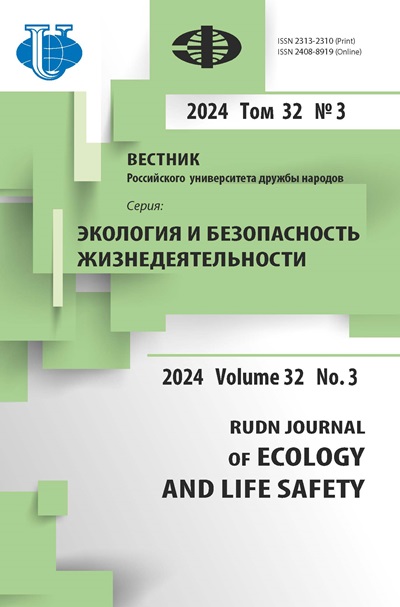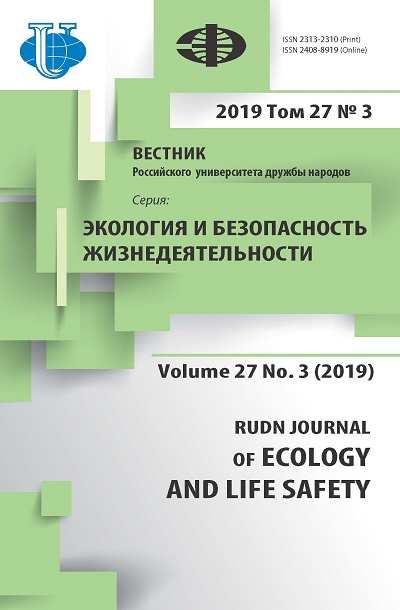Обзор юго-восточной части Нигерии: экологические проблемы и управленческие решения
- Авторы: Калу Н.Н.1, Закирова Ю.Л.1
-
Учреждения:
- Российский университет дружбы народов
- Выпуск: Том 27, № 3 (2019)
- Страницы: 231-240
- Раздел: Управление природными ресурсами
- URL: https://journals.rudn.ru/ecology/article/view/23912
- DOI: https://doi.org/10.22363/2313-2310-2019-27-3-231-240
Цитировать
Полный текст
Аннотация
Целью статьи является рассмотрение экологических проблем в юговосточной части Нигерии и их влияния на общественную деятельность и ценности. Освещаются вопросы уровня жизни и условий окружающей среды, а также возможные решения задач, связанных с сохранением окружающей среды. Изменение климата оказывает сильное влияние на юго-восточную часть Нигерии. В регионе существует целый ряд проблем, начиная от постоянных наводнений, разрушения естественной среды обитания до связанных с окружающей средой осложнений со здоровьем. Авторы отвечают на вопросы о трудностях сохранения окружающей среды и раскрывают причины их возникновения. Важным аспектом является объяснение социального поведения и рисков, которые влечет неосведомленность о косвенном влиянии человеческой деятельности на окружающую среду, когда в фокусе в основном находятся вопросы загрязнения воды, почвы и воздуха. В статье уделено особое внимание постоянным, наиболее устойчивым экологическим проблемам юго-восточной части Нигерии и способам их решения.
Ключевые слова
Полный текст
502.17×
Об авторах
Ннабуезе Нванкво Калу
Российский университет дружбы народов
Email: esteemedthelson@yahoo.com
аспирант кафедры прикладной экологии экологического факультета Российская Федерация, 115093, Москва, Подольское шоссе, д. 8, корп. 5
Юлия Львовна Закирова
Российский университет дружбы народов
Email: nigmatzyanova_yul@rudn.university
кандидат филологических наук, доцент кафедры иностранных языков экологического факультета Российская Федерация, 115093, Москва, Подольское шоссе, д. 8, корп. 5
Список литературы
- NAN. Federal approves N5.56bn for erosion control in six states. The Guardian. 2017, November 8. Available from: https://guardian.ng/news/fg-approves-n5-56bn-for-erosioncontrol-in-six-states (accessed: 20.09.2019).
- Madu IA. Spatial Inequality in Nigeria: The Imperative of Geographic Perspectives in the Development Process. Journal of Social and Economic Development. 2006;8(0.2): 105-120.
- Okonkwo E. Traditional Methods of Preserving Dead Human Bodies in Southeastern Nigeria. ResearchGate; 2014, May. Available from: https://www.researchgate.net/publication/ 273951379_Traditional_Methods_of_Preserving_Dead_Human_Bodies_in_Southeaste rn_Nigeria (accessed: 20.09.2019).
- Monanu P. Temperature and Sunshine: In Nigeria in Maps. Benin City, Ethiope Publishing House; 1975.
- Monanu P. Humidity. In Nigeria in Maps: Eastern States. Ofomata, Ethiope Publishing House; 1975. p. 16-18.
- Lozano RNM. Global and regional mortality from 235 causes of death for 20 age groups in 1990 and 2010: A systematic analysis for the Global Burden of Disease Study 2010. PubMed; 2012, December 15. Available from: https://www.ncbi.nlm.nih.gov/pubmed/ 23245604 (accessed: 20.09.2019).
- WHO. World health Indoor air quality guidelines: household fuel combustion. Geneva, Switzerland. 2014. Available from: https://books.google.ru/books?hl=ru&lr=&id=Hlk0 DgAAQBAJ&oi=fnd&pg=PP1&dq=WHO.+World+health+Indoor+air+quality+guidel ines:+household+fuel+combustion&ots=LhrFikMbHJ&sig=lxS6ZmvKnG1X4dme-DZ c0ZfElfw&redir_esc=y#v=onepage&q=WHO.%20World%20health%20Indoor%20air %20quality%20guidelines%3A%20household%20fuel%20combustion&f=false (accessed: 20.09.2019).
- Egbedi H. Welcome to Onitsha: the city with the world’s worst air. The Guardian. 2017, February 13. Available from: https://www.theguardian.com/cities/2017/feb/13/ polluted-Onitsha-Nigeria-perpetual-dust-city-world-worst-air (accessed: 20.09.2019).
- Alexander RH. Wind as the primary driver of erosion in the Qaidam Basin, China. Earth and Planetary Science Letters. 2013, July 15. Available from: https:// www.sciencedirect.com/science/article/pii/S0012821X13001325 (accessed: 20.09.2019).
- BBC. River processes. BBC bitesize guides. Available from: https://www.bbc.com/ bitesize/guides/zq2b9qt/revision/1 (accessed: 20.09.2019).
- Ashraf SI. Impact of soil erosion and degradation on water quality: a review. Geology, Ecology, and Landscapes. 2017, March 20. Available from: https://www.tandfonline.com/ doi/full/10.1080/24749508.2017.1301053 (accessed: 20.09.2019).
- Tolulope AF, Adebusuyi A. Impact of Poor Land Utilization on Sustainable Human Development in Ado-Odo/Ota of Ogun State, Nigeria. Available from: www.sciencedomain.org: http://www.journalrepository.org/media/journals/ARJASS_45/2016/Jun/Fajobi112016 ARJASS26998.pdf (accessed: 20.09.2019).
- Nigeria floods kill more than 100. BBC News. 2018, September 17. Available from: https://www.bbc.com/news/world-africa-45546695 (accessed: 20.09.2019).
- Gong L, Hou S, Su B, Miao K et al. Short-term effects of moderate and severe floods on infectious diarrheal diseases in Anhui Province, China. PubMed; 2019, April 17. Available from: https://www.ncbi.nlm.nih.gov/pubmed/31030148 (accessed: 20.09.2019).
- Biswajeet PM. A New Approach for Land Degradation and Desertification Assessment Using Geospatial Techniques. ResearchGate; 2017, October. Available from: https:// www.researchgate.net/publication/320335122_A_New_Approach_for_Land_Degradation _and_Desertification_Assessment_Using_Geospatial_Techniques (accessed: 20.09.2019).
- Causes And Solutions To Water Pollution Environmental Sciences Essay. UKeassys; 2018, November. Available from: https://www.ukessays.com/essays/environmentalsciences/causes-and-solutions-to-water-pollution-environmental-sciences-essay.php (accessed: 20.09.2019).
- Wyns A. 25 solution to air pollution. Climate tracker; 2018, October 30. Available from: http://climatetracker.org/25-solutions-to-air-pollution (accessed: 20.09.2019).
- Grant K. 10 measures that must be taken to prevent more flooding in the future. Independent. 2015, December 29. Available from: https://www.independent.co.uk/news/ uk/10-measures-that-must-be-taken-to-prevent-more-flooding-in-the-future-a6788866.html (accessed: 20.09.2019).
- Agwu A, Avoaja AG, Kalu AU. The Assessment of Drinking Water Sources in Aba Metropolis, Abia State, Nigeria. Resources and Environment. 2013;3(4):72-76. doi: 10.5923/ j.re.20130304.02.
















